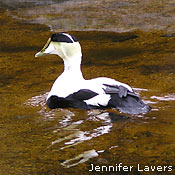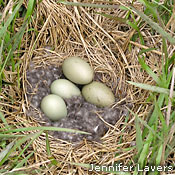Hare Bay Islands Ecological Reserve takes in a trio of islands-Gilliat, Spring, and Brent-on the northeastern edge of Newfoundland’s Great Northern Peninsula, near Main Brook.

- How to get There
- Activities
- Maps
- Services
- Fees and Schedules
- Rules and Regulations
- Permits
- Other Resources
- Contact Information
This seabird ecological reserve was created to protect breeding habitat of the common eider, and in 2004, about 170 common eider nests were found on Gilliat and Spring Islands. The area served as the primary site for an eider duck rehabilitation program, which included a captive rearing project in Hare Bay that ran from 1988 to 1996.
The reserve also contains summer breeding habitat for common and Arctic terns and double-crested cormorant, as well as ring-billed, herring, and great black-backed gulls. Of the 31 km2 in the reserve, 26 km2 is a marine component.
In addition to the seabirds it provides sanctuary for, the reserve also protects many unique geological and ecological features. Rich beds of Early and Middle Ordovician-age fossil gastropods (about 457 million years old) occur throughout the reserve.
The islands are in the Northern Peninsula Forest-Beaver Brook Limestone subregion (997 KB).
The Hare Bay Islands were first protected in 1964 as a wildlife reserve under the Wildlife Act. In 1983 they became the Hare Bay Islands Ecological Reserve, after the Wilderness and Ecological Reserves Act was passed.
How to get there
The Hare Bay Islands are located off the eastern coast of Newfoundland’s Great Northern Peninsula, northeast of Main Brook.
There is no public access to the islands during the breeding season; visits are for scientific research only.
Activities
No activities are permitted on the islands other than scientific research. For more information and research guidelines, see Science and Research.
Commercial and recreational fishing can occur in the waters of the reserve. All provincial and federal regulations apply when fishing in the reserve. Boaters must be careful in the marine portion of the reserve so as not to disturb the birds.
Services
There are no services within the reserve.
Fees and Schedule
There are no fees involved in obtaining scientific research permits. However scientific research permit applications must be submitted to the Parks and Natural Areas Division by March 31 for review by the Seabird Ecological Reserves Advisory Committee.
Rules and Regulations
Biodiversity protection and habitat conservation are two of the key purposes of ecological reserves, so certain rules apply within all the reserves in the province.
The public can visit most ecological reserves for educational purposes or low-impact recreational activities-such as hiking or sightseeing-but these activities are prohibited in the sensitive nesting areas of the Hare Bay Islands. Only those conducting approved scientific research can visit the islands in the reserve during the breeding season.
The following activities are strictly prohibited in all wilderness and ecological reserves:
- Disturbing, destroying, or removing plants, animals, or fossils
- Introducing plants, animals, or anything else to the reserve landscape
- Forestry, mining (including exploration), hydro development, agriculture, new roads, tracks, or building construction
- Driving off-road vehicles including all-terrain vehicles (ATVs)
It is important that boaters approaching the islands do so carefully so as not to disturb the birds.
Read the official reserve regulations:
Regulations and a management plan are pending for the Hare Bay Islands Ecological Reserve.
Adobe® Acrobat® Reader software can be used for viewing PDF documents. Download Acrobat® Reader for free
